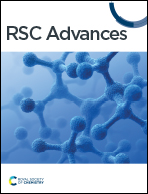Surface modification of halide perovskite using EDTA-complexed SnO2 as electron transport layer in high performance solar cells†
Abstract
The long-term performance of metal halide perovskite solar cells (PSCs) can be significantly improved by tuning the surface characteristics of the perovskite layers. Herein, low-temperature-processed ethylenediaminetetraacetic acid (EDTA)-complexed SnO2 (E-SnO2) is successfully employed as an electron transport layer (ETL) in PSCs, enhancing the efficiency and stability of the devices. The effects of EDTA treatment on SnO2 are investigated for different concentrations: comparing the solar cells' response with 15%–2.5% SnO2 and E-SnO2 based ETLs, and it was found that 7.5% E-SnO2 provided the best results. The improved surface properties of the perovskite layer on E-SnO2 are attributed to the presence of small amount of PbI2 which contributes to passivate the defects at the grain boundaries and films' surface. However, for the excess PbI2 based devices, photocurrent dropped, which could be attributed to the generation of shallow traps due to excess PbI2. The better alignment between the Fermi level of E-SnO2 and the conduction band of perovskite is another favorable aspect that enables increased open-circuit potential (VOC), from 0.82 V to 1.015 V, yielding a stabilized power conversion efficiency of 15.51%. This complex ETL strategy presented here demonstrates the enormous potential of E-SnO2 as selective contact to enhance the perovskite layer properties and thereby allow stable and high-efficiency PSCs.



 Please wait while we load your content...
Please wait while we load your content...